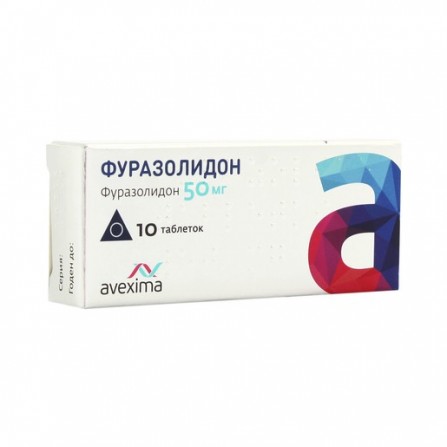More info
Active ingredients
Furazolidone
Release form
Pills
Composition
Active ingredient: Furazolidone Concentration of active ingredient (mg): 50 mg
Pharmacological effect
The drug belongs to the antimicrobial and antiprotozoal agents. Possesses bacteriostatic action in relation to microbes. The mechanism of action is to disrupt the activity of certain enzyme systems of bacteria. Spectrum of action: gram-positive cocci (Streptococcus, Staphylococcus), gram-negative rods (Escherichia, Salmonella, Shigella, Proteus, Klebsiella, Enterobacter), protozoa (Lamblia). Of the causative agents of intestinal infections, the causative agents of dysentery, typhoid and paratyphoid are most sensitive. Resilience develops slowly.
Pharmacokinetics
When administered orally, furazolidone is poorly absorbed and inactivated in the intestine. Only about 5% of the drug is excreted in the urine unchanged or in the form of metabolites, and stains the urine brown.
Indications
Dysentery, paratyphoid, giardiasis, food toxicoinfections.
Contraindications
Pregnancy, lactation. Increased individual sensitivity to the group of nitrofurans. The terminal stage of chronic renal failure, glucose-6-dehydrogenase deficiency, children's age up to 3 years (for this dosage form). With care Chronic renal failure, deficiency of glucose-6-phosphate dehydrogenase, diseases of the liver and nervous system.
Precautionary measures
Store in a dry, dark place, out of reach of children.
Use during pregnancy and lactation
Contraindicated in pregnancy and lactation.
Dosage and administration
Inside, after eating. For dysentery, paratyphoid and foodborne diseases - 100-150 mg 4 times a day (but not more than 800 mg), for 5-10 days. With giardiasis: adults - 100 mg 4 times a day, children - 10 mg / kg / day, distributing the daily dose in 3-4 doses. The highest single dose for adults is 200 mg; daily - 800 mg.
Side effects
Decreased appetite, up to anorexia; nausea, vomiting; allergic reactions (skin rash, hyperemia and itching of the skin, angioedema). With prolonged use - neuritis.
Interaction with other drugs
Furazolidone is an inhibitor of monoamine oxidase: its use must comply with the same precautions as when using other inhibitors of monoamine oxidase. Aminoglycosides and tetracyclines enhance the antimicrobial properties of furazolidone.Sensitizes the body to alcohol. Furazolidone increases blood depression against chloramphenicol and ristomycin.
special instructions
Increases sensitivity to the action of ethanol. Drugs that alkalize urine reduce the effect and acidifiers increase the effect. Aminoglycosides and tetracycline increase antimicrobial properties. Precautions should be followed during treatment, as well as when using monoamine oxidase inhibitors, namely: exclusion from the diet, containing tyramine: cheese, cream, beans, pickled herring, strong coffee. For the prevention of neuritis with prolonged use must be combined with vitamins of group B.





